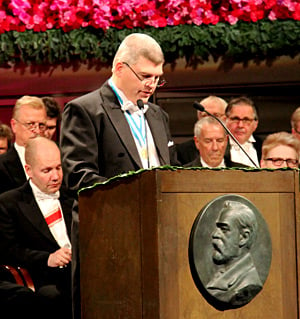Award ceremony speech
English
Presentation Speech by Professor Per Delsing, Member of the Royal Swedish Academy of Sciences, 10 December 2010
 |
| Professor Per Delsing delivering the Presentation Speech for the 2010 Nobel Prize in Physics at the Stockholm Concert Hall. Copyright © The Nobel Foundation 2010 Photo: AnnaLisa B. Andersson |
Your Majesties, Your Royal Highnesses, Ladies and Gentlemen,
The 2010 Nobel Prize in Physics is awarded for research concerning a new ultra-thin material with exceptional properties. This material is called graphene and is the first of a new class of materials. Surprisingly, it can be produced in small quantities with the help of ordinary office materials such as pencils and adhesive tape.
Carbon is probably the most important element in nature. It is the basis of all life that we know of. The most common form of pure carbon is graphite, which we find in pencils, for example. If carbon is subjected to high pressure, it can also assume the form of a diamond, which is considerably more expensive and is undoubtedly found in some of the jewellery in this hall.
Graphite consists of many one-atom-thin layers of carbon stacked on top of each other. One single such layer is what we today call graphene. A graphene layer looks something like chicken wire. We say that it has a hexagonal structure, but graphene is much thinner − actually as thin as one single atom. Each graphene layer is very strong, but in graphite these layers are only weakly connected to each other. Because of this, it is easy to split graphite, which is exactly what happens when we write with a pencil. When we drag a pencil across paper, flakes containing many layers of carbon break loose. Naturally some of the flakes are thinner than others, and it is conceivable that a tiny fraction of the flakes actually consist of single carbon layers. Most of you in this hall have thus produced graphene-like layers when you have written with a pencil.
Graphene is representative of an entire class of two-dimensional crystalline materials. By two-dimensional, we mean that atoms are added to the length and width of such a material but not to its height. This means that electrons in the material can only travel in two dimensions, but not in the third. The electrons in graphene behave in an unusual way. It actually looks as if they have no mass. In physics, this gives rise to interesting phenomena such as an unusual form of the so called quantum Hall effect, a phenomenon which resulted in a Nobel Prize in 1985. Another example is so-called Klein tunnelling. This effect was predicted by the Swedish physicist Oskar Klein in 1929. It had not been observed earlier in other systems, but in graphene it was observed last year.
Graphene also has other exceptional properties. For example, it is 100 times stronger than steel. If we imagine making a hammock out of graphene that is one square metre in size, even though it is only one atom thin it will be able to hold a newborn infant or a cat without breaking. Such a hammock would weigh about one milligram, about the same as one of the cat’s whiskers. Graphene is also a good conductor of electricity, and it conducts heat 10 times better than silver. In addition graphene is transparent, flexible and very stretchable.
It had been known for a long time that graphite consists of hexagonal carbon layers, and the behaviour of electrons in graphene was calculated as early as in 1947 by Philip Wallace, but few scientists believed it would be possible to isolate graphene in a way that would enable electrical measurements of single layers. It was therefore surprising when this year’s Laureates, Andre Geim and Konstantin Novoselov, together with their collaborators published their first article about graphene in October 2004. With the help of inventive methods, including the use of ordinary adhesive tape, they succeeded in isolating thin carbon layers and transferring them to a suitable surface. With the help of different microscopes, they were able to show that some of the layers were only one atom thin. They were also able to etch the samples into a suitable shape and connect electrodes. They made electrical measurements and were able to show that the material actually had the expected properties. In subsequent research, many teams − and not least the Laureates themselves − have performed new experiments and studied a number of exciting properties of this new carbon material.
The graphene research field is still young, and it is too early to single out what applications will be the most important, but there are great hopes that the exceptional properties of graphene can be utilised in many areas. Examples of possible applications are touch screens, solar cells, fast transistors, gas sensors and lightweight super strong materials.
Professor Geim, Professor Novoselov:
You have been awarded the 2010 Nobel Prize in Physics for your groundbreaking experiments regarding the two-dimensional material graphene. On behalf of the Royal Swedish Academy of Sciences, it is my honour and pleasure to convey to you the warmest congratulations for your outstanding work. I now ask you to step forward to receive your Nobel Prizes from the hands of His Majesty the King.
Nobel Prizes and laureates
Six prizes were awarded for achievements that have conferred the greatest benefit to humankind. The 12 laureates' work and discoveries range from proteins' structures and machine learning to fighting for a world free of nuclear weapons.
See them all presented here.
